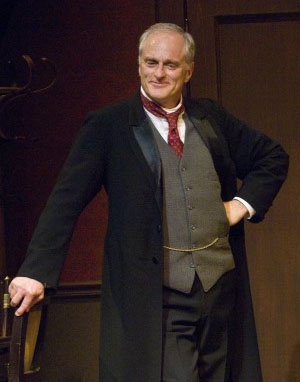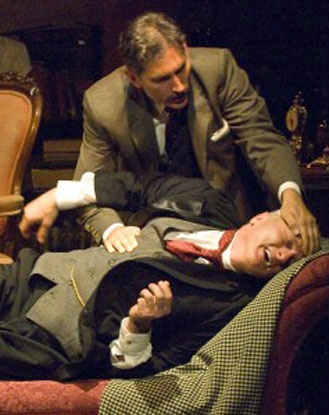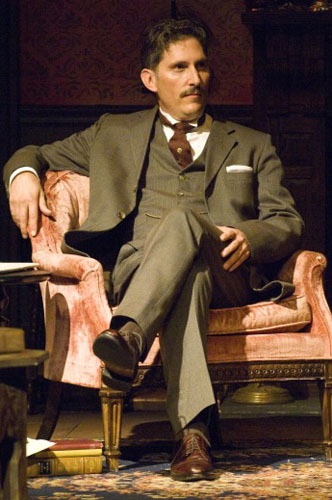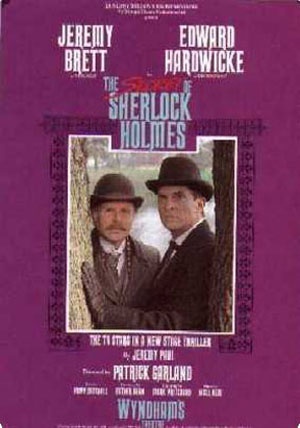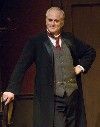The Secret of Sherlock Holmes Revealed in Lenox
American Premiere at Shakespeare and Company
By: Larry Murray - Sep 30, 2007
The Secret of Sherlock Holmes
Written by Jeremy Paul
Directed by Robert Walsh
Set Designer Paulo Seixas
Costume Designer Govane Lohbauer
Lighting Designer Matthew Miller
Sound Designer Bill Barclay
Stage manager Justin Hossle
Run Crew Jessica Bonzek
Sound Michael Pfeiffer
Cast in alphabetical order
Dave Demke...Doctor John Watson
Michael Hammond...Sherlock Holmes
At the Founders Theatre, Shakespeare and Company
September 28-October 28
70 Kemble Street, Lenox, MA
413-637-1199
After a few seconds of Watson's prattling, Sherlock Holmes erupts: "Watson, tell the truth! Or, at least as much of it as your gullible public can digest!"
The audience of Sherlockians like myself laughs as one quip follows another. The first act sets off with a roar of approval, and the witty banter between Holmes and Doctor John Watson begins to establish the relationship between the two men.
It seems that Watson is taking the measure of Holmes even as the famous detective is probing his future partner. After some give and take in which Watson discovers huge voids in the detective's education, he issues a report card on Holmes' depth of knowledge: "Philosophy nil, Astronomy, nil. Politics, feeble. Botany, variable: well up in belladonna, opium and poisons generally."
The play is mostly concerned with the relationship between the two men and the details are largely drawn from Sir Arthur Conan Doyle's own words. This lends authenticity to the dialogue, and while the relationship is warm and friendly in words, it is cold and distant in practice. The many "dear friend" statements are quickly undermined by the superficial practices of the Victorian era.
Still, at one point, Holmes makes the startling admission that: "A man needs a companion--he cannot sit alone...there never was a better friend, and I treated him abominably."
Michael Hammond and Dave Demke work together brilliantly as Holmes and Watson, and create a feeling akin to overhearing old pals chatting. In their hands you get to meet far more than a clever detective and befuddled sidekick. Hammond dispenses with the stereotyped deerstalker hat and calabash pipe, giving us a more natural Holmes. Demke's character is assured as a person, but seems helpless in the face of the black fits of Holmes. Dr. Watson watches his friend suffer, but is unable to provide any lasting help - medical, physical, emotional or spiritual. Both acquit their roles as British Gentlemen with panache, rising above the problems with the script, which relies more on pastiche than plot. In fact, director Robert Walsh has to be credited for helping make the whole production shine.
This is the play's American premiere and though the original production was intended to play here, it never did. It is no secret that the second act is a tough one to do well. The playwright was dealt with harshly by London critics in 1988. That initial production starred Jeremy Brett and Edward Hardwicke in the roles of Holmes and Watson. The problem comes towards the end of Act II, following the revelation of the secret. At that point, playwright Jeremy Paul seems to run out of steam, as the characters retire into their old and comfortable relationship, like husband and wife following the discussion of a momentary indiscretion. The play ends more with a whimper than a bang.
I found it interesting that director Walsh had the two acts break in a different place than the original West End production. In the earlier version, the first act showed the death of Holmes and his evil nemesis Moriarity, and continued on to the first few sections of the current second act in which he reappears.
In the Shakespeare and Company production, the first act stops at the point of the double death. It works well as an ending due to the clever bit of staging which is accomplished through the use of shadows and lighting.
This enables the second half to begin with the re-appearance of Holmes after an absence of three years. As directed by Walsh, it is an absolute tour-de-force, one that Demke and Hammond milk for all its worth. It gets Act II off to a rollicking start, and is an improvement in my book.
After a bit of stage business, Holmes finds his way to Watson's house and whips off his disguise to reveal his true identity, then turns away to stow his wig and hat. Unseen by Holmes, Watson faints dead away on the floor. while Holmes is now fiddling with his greatcoat. He turns back to see his friend on the floor and says, with ultimate understatement: "I had no idea you'd be so affected!"
In London, this scene ended Act I. The second act was used to explain where Holmes had been for three years. (Tibet, the Holy Lama.) Watson counters that he knew all the time and the two compare notes on how they deceived the other, but ended up knowing. But. if Watson knew all the time, was his fainting just an act? Did Sherlock fool him at all, or are we witnessing a factual, but fanciful, game of chess between the two?
Now, that, my friend, is the real "Secret" of Sherlock Holmes, and good reason to visit Lenox and play the game along with these legendary characters.
I wanted to note that Michael Hammond, who plays Holmes with gusto, is also Associate Artistic Director of Shakespeare and Company. Once again we are fortunate to see artistic directors of Berkshire theatre companies showcase their talents and hold an audience in thrall. Kate Maguire, in Glass Menagerie, Roger Rees in The Physicists, and Tina Packer as Cleopatra, are other Berkshire artistic directors of companies who have proven their bona fides on the boards this year.
I wish the author had spent a little longer on the second act. And I have another quibble. The action takes place in Baker Street, Doctor Watson's surgery, and various other parts of London and Switzerland. The sets were clever though painted an unconvincing mishmash of colors and styles. This was partially redeemed by gallant efforts to fill in details by an unspecified prop collector. But I felt the use of jaggedly arranged pieces of commercial laminate flooring on stage should have been disguised with a little stain on the contrasting edges. I know there are serious budget constraints in the Berkshires, but a $1 marker pen or two would have toned down the glaring incongruity of that barely disguised Home Depot make-do. The wardrobe, lighting and sound were all seamlessly done. Kudos.
Minor problems aside, I think the overall production excelled, and could credibly be a candidate for the PBS Mystery series, since the acting and staging were outstanding, even with actors occasionally walking through the imaginary walls. Certainly the problematic denouement of the latter part of the second act would play better on television, since that is the medium Jeremy Paul specialized in. With a few tweaks, the Shakespeare and Company version is ready for prime time.
Shakespeare and Company is celebrating the 120th Anniversary of the Sherlock Holmes Canon, and has a fascinating variety of special events built around this production. Click on the link for more information.


